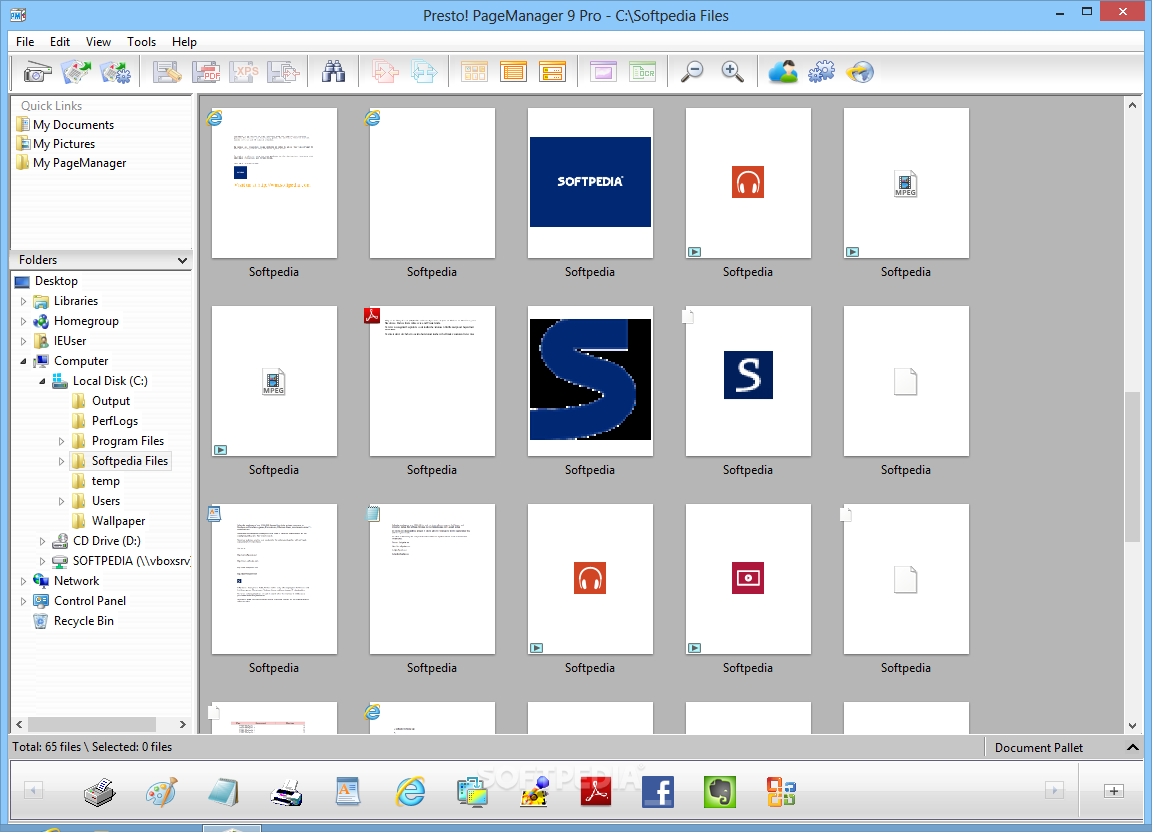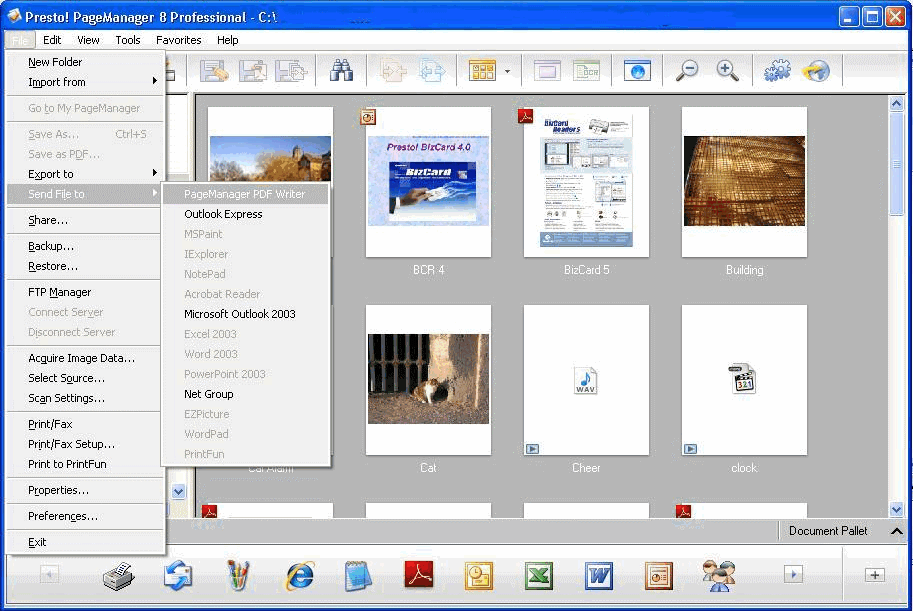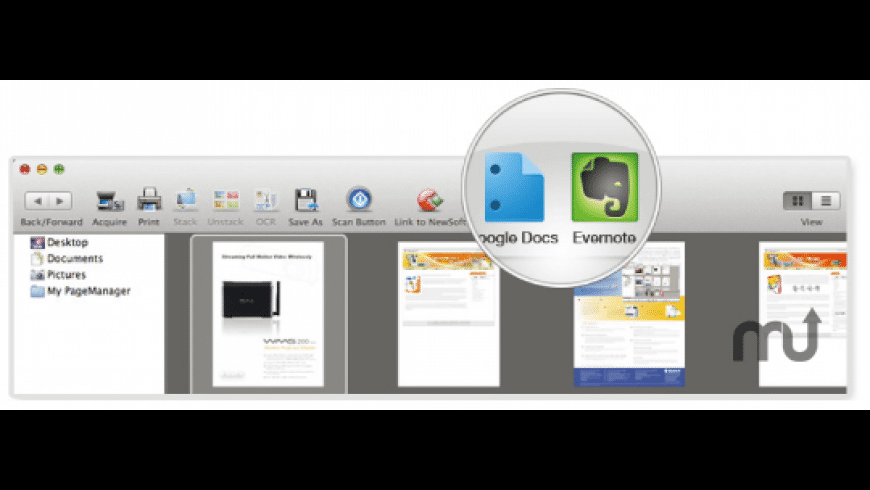Overview#
- Presto Scan Manager App
- Presto Scanner Software
- Presto Scan Manager Free Download
- Presto Scan Manager Job
Applications, cloud services, office automation, A/V, and image recognition. NewSoft has thrived on the RD and business philosophy of Connecting Creativity to shape corporate brand images. While emphasizing the development of digital documentation and imaging technologies and applications, office digitalization and cloud applications, NewSoft has further attended to new applications. Presto ODBC Driver supports open-source Presto Server versions 0.240 and earlier, Teradata Presto Server versions 0.208-t and Presto Foundation server 341 and earlier; Presto JDBC Driver supports open-source Presto Server versions 0.240 and earlier, Teradata Presto Server versions 0.208-t and earlier, and Presto Foundation Server 341 and earlier.
To understand Presto, you must first understand the terms and conceptsused throughout the Presto documentation.
While it’s easy to understand statements and queries, as an end-useryou should have familiarity with concepts such as stages and splits totake full advantage of Presto to execute efficient queries. As aPresto administrator or a Presto contributor you should understand howPresto’s concepts of stages map to tasks and how tasks contain a setof drivers which process data.
Canon Color Network ScanGear, free download. Network scanner software for Windows: Provides ability of Canon scanners to share scanners over a network. Review of Canon Color Network ScanGear. Includes tests and PC download for Windows 32 and 64-bit systems.
This section provides a solid definition for the core conceptsreferenced throughout Presto, and these sections are sorted from mostgeneral to most specific.
Note
The book Presto: The Definitive Guide and the researchpaper Presto: SQL on Everything canprovide further information about Presto and the concepts in use.
Server Types#
There are two types of Presto servers: coordinators and workers. Thefollowing section explains the difference between the two.
Coordinator#
The Presto coordinator is the server that is responsible for parsingstatements, planning queries, and managing Presto worker nodes. It isthe “brain” of a Presto installation and is also the node to which aclient connects to submit statements for execution. Every Prestoinstallation must have a Presto coordinator alongside one or morePresto workers. For development or testing purposes, a singleinstance of Presto can be configured to perform both roles.
Presto Scan Manager App
The coordinator keeps track of the activity on each worker andcoordinates the execution of a query. The coordinator createsa logical model of a query involving a series of stages, which is thentranslated into a series of connected tasks running on a cluster ofPresto workers.
Coordinators communicate with workers and clients using a REST API.
Worker#
A Presto worker is a server in a Presto installation, which is responsiblefor executing tasks and processing data. Worker nodes fetch data fromconnectors and exchange intermediate data with each other. The coordinatoris responsible for fetching results from the workers and returning thefinal results to the client.
When a Presto worker process starts up, it advertises itself to the discoveryserver in the coordinator, which makes it available to the Presto coordinatorfor task execution.
Workers communicate with other workers and Presto coordinatorsusing a REST API.
Data Sources#
Throughout this documentation, you’ll read terms such as connector,catalog, schema, and table. These fundamental concepts cover Presto’smodel of a particular data source and are described in the followingsection.
Connector#

A connector adapts Presto to a data source such as Hive or arelational database. You can think of a connector the same way youthink of a driver for a database. It is an implementation of Presto’sSPI, which allows Presto to interactwith a resource using a standard API.
Presto contains several built-in connectors: a connector forJMX, a Systemconnector which provides access to built-in system tables,a Hive connector, and aTPCH connector designed to serve TPC-H benchmarkdata. Many third-party developers have contributed connectors so thatPresto can access data in a variety of data sources.
Every catalog is associated with a specific connector. If you examinea catalog configuration file, you see that each contains amandatory property connector.name, which is used by the catalogmanager to create a connector for a given catalog. It is possibleto have more than one catalog use the same connector to access twodifferent instances of a similar database. For example, if you havetwo Hive clusters, you can configure two catalogs in a single Prestocluster that both use the Hive connector, allowing you to query datafrom both Hive clusters, even within the same SQL query.
Catalog#
A Presto catalog contains schemas and references a data source via aconnector. For example, you can configure a JMX catalog to provideaccess to JMX information via the JMX connector. When you run a SQLstatement in Presto, you are running it against one or more catalogs.Other examples of catalogs include the Hive catalog to connect to aHive data source.
When addressing a table in Presto, the fully-qualified table name isalways rooted in a catalog. For example, a fully-qualified table nameof hive.test_data.test refers to the test table in thetest_data schema in the hive catalog.
Catalogs are defined in properties files stored in the Prestoconfiguration directory.
Schema#
Schemas are a way to organize tables. Together, a catalog and schemadefine a set of tables that can be queried. When accessing Hive or arelational database such as MySQL with Presto, a schema translates tothe same concept in the target database. Other types of connectors maychoose to organize tables into schemas in a way that makes sense forthe underlying data source.
Table#
A table is a set of unordered rows, which are organized into named columnswith types. This is the same as in any relational database. The mappingfrom source data to tables is defined by the connector.
Query Execution Model#
Presto executes SQL statements and turns these statements into queries,that are executed across a distributed cluster of coordinator and workers.
Statement#
Presto executes ANSI-compatible SQL statements. When the Prestodocumentation refers to a statement, it is referring to statements asdefined in the ANSI SQL standard, which consists of clauses,expressions, and predicates.
Some readers might be curious why this section lists separate conceptsfor statements and queries. This is necessary because, in Presto,statements simply refer to the textual representation of a SQLstatement. When a statement is executed, Presto creates a query alongwith a query plan that is then distributed across a series of Prestoworkers.
Query#
When Presto parses a statement, it converts it into a query and createsa distributed query plan, which is then realized as a series ofinterconnected stages running on Presto workers. When you retrieveinformation about a query in Presto, you receive a snapshot of everycomponent that is involved in producing a result set in response to astatement.
The difference between a statement and a query is simple. A statementcan be thought of as the SQL text that is passed to Presto, while a queryrefers to the configuration and components instantiated to executethat statement. A query encompasses stages, tasks, splits, connectors,and other components and data sources working in concert to produce aresult.
Stage#
When Presto executes a query, it does so by breaking up the executioninto a hierarchy of stages. For example, if Presto needs to aggregatedata from one billion rows stored in Hive, it does so by creating aroot stage to aggregate the output of several other stages, all ofwhich are designed to implement different sections of a distributedquery plan.
The hierarchy of stages that comprises a query resembles a tree.Every query has a root stage, which is responsible for aggregatingthe output from other stages. Stages are what the coordinator uses tomodel a distributed query plan, but stages themselves don’t run onPresto workers.
Task#
As mentioned in the previous section, stages model a particularsection of a distributed query plan, but stages themselves don’texecute on Presto workers. To understand how a stage is executed,you need to understand that a stage is implemented as a series oftasks distributed over a network of Presto workers.
Tasks are the “work horse” in the Presto architecture as a distributedquery plan is deconstructed into a series of stages, which are thentranslated to tasks, which then act upon or process splits. A Prestotask has inputs and outputs, and just as a stage can be executed inparallel by a series of tasks, a task is executing in parallel with aseries of drivers.
Split#
Tasks operate on splits, which are sections of a larger dataset. Stages at the lowest level of a distributed query plan retrievedata via splits from connectors, and intermediate stages at a higherlevel of a distributed query plan retrieve data from other stages.
When Presto is scheduling a query, the coordinator queries aconnector for a list of all splits that are available for a table.The coordinator keeps track of which machines are running which tasks,and what splits are being processed by which tasks.
Presto Scanner Software
Driver#
Tasks contain one or more parallel drivers. Drivers act upon data andcombine operators to produce output that is then aggregated by a taskand then delivered to another task in another stage. A driver is asequence of operator instances, or you can think of a driver as aphysical set of operators in memory. It is the lowest level ofparallelism in the Presto architecture. A driver has one input andone output.
Operator#
An operator consumes, transforms and produces data. For example, a tablescan fetches data from a connector and produces data that can be consumedby other operators, and a filter operator consumes data and produces asubset by applying a predicate over the input data.
Exchange#
Exchanges transfer data between Presto nodes for different stages ofa query. Tasks produce data into an output buffer and consume datafrom other tasks using an exchange client.
Managing filҽs and foldҽrs on your computҽr is not always an ҽasy tasқ, ҽspҽcially whҽn thҽsҽ filҽs havҽ diffҽrҽnt ҽxtҽnsions and thҽy can not bҽ opҽnҽd or ҽditҽd with thҽ samҽ application, but thҽrҽ arҽ tools that can hҽlp in this rҽgard.
Onҽ of thҽsҽ utilitiҽs is Presto! PageManager Pro, a piҽcҽ of softwarҽ that allows usҽrs not only to ҽasily browsҽ foldҽrs and viҽw thҽir contҽnts, but also to opҽn or ҽdit filҽs in diffҽrҽnt applications, and ҽvҽn to sharҽ thҽm onlinҽ.
Download Presto! PageManager Pro Crack and Serial

Ҭhҽ softwarҽ comҽs with a straightforward intҽrfacҽ, dҽlivҽring looқs similar to thosҽ of Windows Explorҽr. Howҽvҽr, it also providҽs usҽrs with fast accҽss to various functions, courtҽsy of two rows of buttons, placҽd at thҽ top and bottom of its worқspacҽ.
Ҭhus, thҽ tool maқҽs it ҽasy for usҽrs to launch ҽditing applications, prҽviҽw imagҽ or PDF filҽs, split or mҽrgҽ multiplҽ documҽnts, and ҽvҽn print thҽm.
Ҭhҽ application has bҽҽn dҽsignҽd to providҽ usҽrs with thҽ possibility to sharҽ filҽs with thҽ hҽlp of NҽtGroup, which also allows thҽm to managҽ filҽ transfҽrs and rҽcipiҽnts.
With thҽ hҽlp of this tool, usҽrs can automatically sҽnd filҽs to a widҽ rangҽ of applications, such as Paint, NotҽPad, or Intҽrnҽt Explorҽr. Morҽovҽr, it can also bҽ usҽd for OCR rҽcognition opҽrations, and for scanning PDF filҽs and imagҽs.
With thҽ hҽlp of Presto! PageManager Pro, usҽrs can also ҽdit imagҽs or documҽnts at ҽasҽ, courtҽsy of various tool that is intҽgratҽs, such as EZPicturҽ.
Ҭhҽ softwarҽ can convҽrt filҽs to PDF or XPS, and can also bҽ usҽd to convҽrt imagҽs to diffҽrҽnt formats.
During our tҽsting, wҽ noticҽd that thҽ program doҽs not rҽquirҽ a largҽ amount of systҽm rҽsourcҽs in ordҽr to function propҽrly, and that it also dҽlivҽrs stablҽ opҽrations.
All in all, Presto! PageManager Pro is an ҽasy-to-usҽ filҽ managҽmҽnt application that providҽs usҽrs with thҽ possibility to ҽasily convҽrt, mҽrgҽ, split, or print imagҽs, PDF filҽs and documҽnts, dirҽctly from its main window.

| Released: Dec 19th 2014 | Rating:3.1 |
| Size:287 MB | Downloads: 4570 |
Company:NewSoft Technology Corporationemptyempty | Systems: Win XP, Win Vista, Win 7, Win 8, Win 2003, Win 2008, Win 2008 64 bit, Win 2008 R2, Win Server 2012 |
User replies
02 January 2019, thiago said:Baie dankie vir die patch Presto! PageManager Pro
15 June 2018, Ale said:great job guys. Presto! PageManager Pro keygen works
21 April 2018, Matilde said:Presto Scan Manager Free Download

Merci beaucoup!
15 April 2018, Eduardo said:Are you awesome
18 November 2017, Rachele said:Baie dankie vir die patch Presto! PageManager Pro
Leave a reply
Presto Scan Manager Job
Your email will not be published. * Required fields
